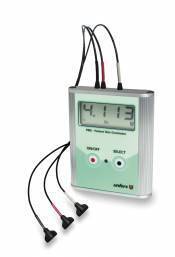La dosis “alarmar de la piel del humo” podía ayudar a prevenir accidentes de la exploración de CT
por
Brendon Nafziger, DOTmed News Associate Editor | March 24, 2010

The Patient Skin Dosimeter could
help prevent radiation overexposure
accidents from CT, fluoro, scans, Xray
CT Xray began distributing a skin dosimeter that measures radiation dose exposure from CT scans and fluoroscopy in real-time, DOTmed News has learned.
The Bantam, CT-based business hopes the device, known as a Personal Skin Dosimeter, or PSD, could help cut down on the sort of overexposure accidents that grabbed headlines recently.
CT Xray launched the PSD in early March, after having gotten non-exclusive U.S. distribution rights from the developers, Unfors, a Billdal, Sweden-based manufacturer of measuring instruments.
Although not new, the device is being given a new marketing push.
"[Unfors] got their 510 (k) [U.S. FDA clearance] on the product four or five years ago, but they haven't been actively marketing it," Doug Steers, president of CT Xray, tells DOTmed News. Steers suspects they weren't aggressive in pushing it because most of their customers are medical businesses doing technical calibrations, not the hospital lawyers, risk management specialists and radiation safety officers who would be interested in the PSD.
Steers believes the highly publicized stories from last year of patients at the Cedars-Sinai hospital in Los Angeles receiving CT radiation overdoses reveal the tragic necessity of his product.
"That represented an unfortunate circumstance but a great business opportunity," Steers admits. "Here's a product that's designed to alarm and inform the RTs [radiologic technicians] when a patient is being severely overdosed. Had they been using this product or a similar product when those patients were being blasted, literally lights and sirens [would have gone] off. The problem would have been mitigated," he said.
How it works
The PSD comprises a set of small photo-diode devices that get taped to the patient's skin in the area that's going to be imaged, Steers explains.
The device monitors all radiation exposure. When dose levels reach a percentage of a threshold programmed by the user, such as 2 Gy (a dose known to cause radiation damage), the PSD gives out a series of increasingly noisy alarms.
"As soon as a patient receives [25 percent of] that level, the device starts beeping. When it gets to 75 percent, it beeps louder and faster. And when it gets to 100 percent there's a continuous screeching tone," says Steers.
Currently, doses from CT scans are often monitored by GAF chromic detectors. This involves taping GAF chromic film to a patient's body, and then after the procedure is finished, checking the amount of radiation they received.
"It's a passive type of monitoring," says Steers. "You only know after the fact that something went wrong."
However, Steers says that following regulations passed a few years ago, new CT scanners hitting the market are now required to include dose detectors built into the equipment. But because most CT scanners in use don't feature these detectors now, Steers thinks there's a lot of life left in his product.
"One of the latest regulations is that all CTs will have to have patient dose monitoring, but that will come after they replace the entire installed base of CTs in the U.S.," he says.
"It'll happen eventually, but it's not going to happen quickly," he predicts.
The PSD costs between $2,500 and $4,500, depending on whether the user buys one or four detectors.
"It's a very reasonable price, when you consider the risk-mitigation value of the product," Steers argues.
